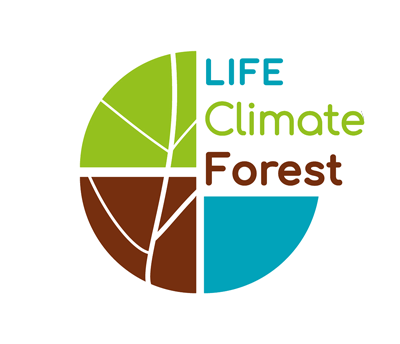
Forest area 't Zand
In the winter of 2022-2023, the first measures will be taken in demo forest 't Zand within the LIFE Climate Forest project. 't Zand is owned by the municipality of Alphen-Chaam. Bosgroep Zuid Nederland has been managing it for several years on behalf of the municipality. It is a reclaimed forest on former drifting dunes, with mainly pine species (Pinus sp.) as the main tree species in the canopy.
Forests on these dry and poor growth sites have been shown to be vulnerable to the impacts of climate change. The aim of the measures within LIFE Climate Forest is to strengthen the forest against climate change and other disturbances by increasing its resilience. In this way, a forest can better tolerate climate change and is also better able to adapt to changing conditions. Especially in this forest, we have been working on diversity and structure for a long time, especially by allowing specific deciduous trees to grow through from the understorey in places. In 't Zand we can therefore show what can be achieved in the long run with climate-smart measures.
Small-scale tree-oriented forest management
About 10 years ago, people in 't Zand switched to tree-oriented forest management with an approach that we bostracken have come to be called. This management focuses on the quality and vitality of individual trees, and decisions on management interventions are taken on a spot-by-spot basis. Meanwhile, the results of this are becoming increasingly visible. 't Zand has a remarkably dense shrub layer with lots of dirty tree, oak and birch. Especially the quality of the oaks was reason to switch from a group rejuvenation strategy to tree-oriented forest management in those places. Under the screen of pines, oaks and the occasional birch were then selected as future trees in combination with mature pines. In selected oaks, restraint was exercised by mainly providing light directly above the crown. In this way, the oak can form a larger crown and continue to grow, thus greatly improving its vitality against disturbances. At the same time, the upper crown layer with Scots pine remains intact as much as possible, so that it can absorb extreme weather conditions like a kind of screen and thus maintain the forest microclimate for the layers below.
Now that the trees have had some time to develop, it is clear to see that the forest is developing into a mixed deciduous forest.

In 't Zand, scattered older oaks are also already growing, and they are given all the space they need to grab a place in the crown canopy. Slowly, the forest area is developing towards a mixed forest with a lot of hardwood. To strengthen its resilience, we will continue to focus on more tree species and deciduous trees.
Continuing with forest tracking

Selected as a future tree, this oak was carefully released to allow it to gain vitality and grow into the canopy.
In this demo forest, we mainly want to show the longer-term effects of forest tracing and gain more experience with this methodology. We also want to get a better grip on spot rejuvenation through small-scale planting or natural rejuvenation. Key objectives here are to further enhance mixing and increase the proportion of richer litter. With a greater mix of tree species, more seed sources are present in the forest and the forest is able to adapt more quickly to future disturbances. With a higher proportion of rich litter species, the aim is to make nutrients more available on these poor sandy soils.
Bosgroep Zuid Nederland will therefore revisit forest tracing, assessing whether the oaks already selected need some more light again. Furthermore, we will identify new opportunities for planting and natural rejuvenation. Now that we are forest tracing again, these have already been noticed.
The challenge is to dose management interventions to allow the new generation to grow on and strengthen the structure, while at the same time maintaining the screen and forest climate as much as possible. Spotwise, rejuvenation is also encouraged by bespoke interventions in the crown canopy. An additional reason for retaining the old pines, is that it is still unknown how quickly the new generation of oaks and birches can also act as cost carriers for management. We will closely follow the development of this strategy within this project, with monitoring focused on forest structure and the management effort required.
Attention to light availability
Another concern is the effect of light availability on planting survival. We plant under the existing forest in small groups ranging from a few trees to groups of 25. For each planting site, we optimise light availability, not necessarily intervening only in the crown canopy above the planting. We also assess whether light can sufficiently invade laterally. Monitoring over the next few years will help us understand the intended results and provide guidance for future management. All this to be able to increase the resilience of a forest ecosystem on sandy soils.
Follow-up and monitoring
This season, we are working on forest tracing and dosed management interventions in the canopy. Then, in the coming growing season, we will assess which species we can best plant at which planting spots, and whether additional interventions are needed to optimise the light climate. Planting will then follow in the winter of 2023-2024. From then on, we will monitor the development in 't Zand and demonstrate the effects of the management measures taken for knowledge sharing and knowledge dissemination.


